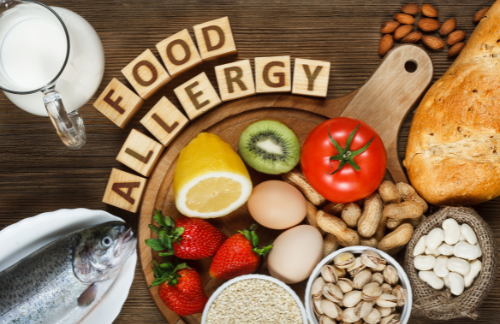
(The Journal of Allergy and Clinical Immunology)
Food allergies in children represent a significant and growing health concern. These food allergies occur when a child’s immune system reacts to specific proteins found in foods, mistakenly identifying them as harmful. This response can lead to a range of symptoms, from mild itching to severe anaphylaxis. The rising prevalence of food allergies among children highlights the need for awareness and understanding. Common allergens include peanuts, eggs, milk, and tree nuts. Additionally, food allergies impact not only physical health but also a child’s emotional well-being and social interactions.
Understanding the nature of food allergies, their symptoms, and prevention strategies is vital for managing and reducing risks. Ongoing studies and expert guidelines provide valuable insights into effective management and treatment. By staying informed and proactive, parents can help their children navigate daily challenges associated with food allergies and lead healthier, more fulfilling lives.
Food Allergy in Children: Research and Facts
– What is Food Allergy in Children?
Food allergy in children is an immune response triggered by harmless proteins found in certain foods. The body mistakenly identifies these proteins as harmful, causing allergic reactions. According to a study published in « The Journal of Allergy and Clinical Immunology « , a 2008 Centers for Disease Control and Prevention report indicated an 18% increase in childhood food allergy from 1997 to 2007, with an estimated 3.9% of children currently affected, and recorded also that food allergies affect 8% of children in the U.S. alone . This condition is more common in children than adults, with some studies suggesting that food allergies may develop as early as infancy .
– Range of Reactions: From Mild to Severe
Food allergy reactions can vary significantly, from mild symptoms like itching to severe anaphylaxis. Research from the « American Academy of Pediatrics » emphasizes the importance of early diagnosis and treatment to prevent life-threatening reactions . According to the same study, milk, eggs, and peanuts are the most common allergens responsible for severe reactions in children .
– Importance of Understanding Food Allergies in Children
Understanding food allergies is critical for ensuring your child’s well-being and avoiding potentially dangerous situations. The « Centers for Disease Control and Prevention (CDC) » reports that food allergies can impact children’s quality of life, leading to anxiety about food consumption, particularly in public or social settings . Knowing the symptoms and common triggers can help parents and caregivers manage these risks effectively.
– What Causes Food Allergy in a Child?
A child’s immune system reacts to certain proteins found in food, triggering an allergic reaction. Moreover, a family history of allergies increases the risk of a child developing food allergies. While some food allergies may be outgrown, others can persist throughout life..
– Role of Prevention and Research
Research published in « The New England Journal of Medicine » highlights that early introduction of allergenic foods like peanuts may help reduce the likelihood of developing allergies . The « LEAP Study – Learning Early About Peanut Allergy »(1) supports this, showing a significant decrease in peanut allergies in children who were introduced to peanuts early in life .
Understanding food allergies, educating caregivers, and staying updated with the latest research are essential steps for protecting children from potential health risks.
What is the Most Common Food Allergy in children?

The most common food allergies in toddlers include peanuts, eggs, milk, and wheat. Tree nuts, soy, and fish are also prevalent allergens. Knowing these common allergens helps parents avoid potential allergic reactions.
Symptoms and Diagnosis of Food Allergies
– What are the Symptoms of Food Allergies in Children?
Symptoms of food allergies in children include hives, rashes, vomiting, and stomach pain. However, some children may experience mild symptoms, such as itching or swelling. These symptoms usually appear within minutes of eating the allergen, making diagnosis easier.
– Severe Symptoms of a Food Allergy
Severe food allergy symptoms can include difficulty breathing, swelling, or loss of consciousness. These symptoms require immediate medical attention, making it essential to recognize them quickly.
– How is Food Allergy Treated in a Child?
Treating food allergies in children often involves avoiding the allergenic food and carrying an epinephrine auto-injector for emergencies. Moreover, working closely with a healthcare provider helps manage the condition. Keeping a list of common food allergies in children ensures parents can protect their child effectively.
Preventing and Managing Food Allergies
– What Can I Do to Prevent Food Allergy in My Child?
There is no certain way to prevent food allergies, but introducing common allergens early may reduce the risk. Additionally, breastfeeding has shown some protective effects against the development of food allergies in children. Maintaining a healthy eating meal plan can also help in managing any potential allergic reactions.
– How to Help Kids with Food Allergies?
Parents can help kids with food allergies by creating a safe food environment at home and school. Moreover, educating your child about their food allergies ensures they avoid trigger foods when not under supervision. You can further help by educating caregivers, teachers, and friends about the allergy and its symptoms.
Helping Your Child Live with a Food Allergy

– How Can I Help My Child Live with a Food Allergy?
Managing a food allergies requires constant vigilance, but it is possible to help your child lead a normal life. For instance, regular communication with schools and caregivers helps prevent accidental exposure to allergens. Moreover, teaching your child to read labels and ask about ingredients ensures they stay safe.
– Key Points About Food Allergy in Children
Food allergies in children are common and can pose serious health risks. With proper management and education, parents can help their children live safely with food allergies. Early diagnosis, prevention strategies, and open communication are crucial.
Kid-friendly recipes that avoid common allergens
Here are 30 kid-friendly recipes that avoid common allergens like peanuts, tree nuts, dairy, eggs, soy, and gluten. Each recipe focuses on providing nutritious, tasty options suitable for children with food allergies.
Quinoa and Veggie Stir-Fry

Instructions: Cook quinoa. Stir-fry vegetables in olive oil with garlic and ginger. Mix with quinoa.
Apple and Cinnamon Oatmeal

Instructions: Cook oats with water or rice milk. Stir in chopped apples and cinnamon.
Peach and Almond Smoothie

Instructions: Blend peaches with almond milk and flax seeds for a creamy smoothie.
Chicken and Sweet Potato Skewers

Instructions: Cut chicken and sweet potatoes into cubes. Toss with olive oil and rosemary. Skewer and bake.
Turkey and Spinach Meatballs

Instructions: Mix ground turkey with finely chopped spinach and seasonings. Form into meatballs and bake.
Hummus and Veggie Wraps

Instructions: Spread hummus on tortillas. Add sliced veggies and roll up.
Banana and Berry Smoothie

Instructions: Blend bananas, berries, and coconut water until smooth.
Zucchini Noodles with Tomato Sauce

Instructions: Spiralize zucchini into noodles. Sauté with homemade tomato sauce.
Avocado and Chicken Salad

Instructions: Mix shredded chicken with diced avocado and chopped celery. Add lemon juice.
Vegetable Soup

Instructions: Simmer vegetables in broth with garlic and thyme until tender.
Roasted Chickpeas

Instructions: Toss chickpeas with olive oil and spices. Roast until crunchy
Rice and Black Bean Burritos

Instructions: Fill tortillas with rice, beans, and corn. Roll up and serve.
Cucumber and Turkey Roll-Ups

Instructions: Spread avocado on turkey slices, place cucumber slices, and roll up.
Baked Apple Slices

Instructions: Slice apples, sprinkle with cinnamon, and bake until tender.
Homemade Applesauce

Instructions: Cook peeled apples with cinnamon until soft. Mash or blend.
Veggie-Stuffed Bell Peppers

Instructions: Stuff peppers with a mixture of rice, beans, corn, and tomatoes. Bake.
Sweet Potato and Black Bean Tacos

Instructions: Roast sweet potatoes. Fill tortillas with sweet potatoes, beans, and avocado.
Oat and Banana Energy Balls

Instructions: Mash bananas and mix with oats and chia seeds. Form into balls.
Coconut Rice Pudding

Instructions: Combine rice with coconut milk and maple syrup. Cook until thickened.
Baked Salmon with Lemon

Instructions: Drizzle salmon with olive oil and lemon juice. Season with dill. Bake until cooked.
Butternut Squash Soup

Instructions: Sauté onions and garlic, add squash and broth. Simmer and blend.
Chia Seed Pudding

Instructions: Mix chia seeds with coconut milk and sweetener. Chill until thickened.
Crispy Roasted Brussels Sprouts

Instructions: Toss Brussels sprouts with olive oil and seasonings. Roast until crispy.
Stuffed Acorn Squash

Instructions: Roast squash halves. Stuff with a mixture of quinoa, cranberries, and spinach.
Sweet Potato Pancakes

Instructions: Mash sweet potatoes and mix with flour and spices. Cook pancakes on a griddle.
Turkey and Veggie Sliders

Instructions: Mix ground turkey with finely grated veggies. Form into sliders and bake.
Fruit Kabobs

Instructions: Skewer pieces of fruit onto sticks. Serve as a fun, healthy snack.
Coconut Shrimp

Instructions: Coat shrimp with coconut flakes and cook in coconut oil until crispy.
Cauliflower

Ingredients: Cauliflower, olive oil, garlic.
Instructions: Process cauliflower into rice-like texture. Sauté with garlic and olive oil.
Pear and Berry Compote

Instructions: Cook pears and berries with a touch of cinnamon until soft.
These recipes are designed to avoid common allergens while providing nutritious and enjoyable meals for kids. Adjustments can be made based on individual dietary needs and preferences.
Conclusion
Understanding food allergies in children is crucial for maintaining their health and safety. By staying informed about the most common food allergies and their symptoms, parents can protect their children from potential dangers. Moreover, working closely with healthcare providers and educating children about their allergies ensures a safer environment for them to grow and thrive.
You can read more articles:
– Eating Disorders in Children (I)
– Eating Disorders In Children (II)
– Therapeutic Food Recipes for Children: A Natural Approach to Minor Illnesses
- Learning Early About Peanut Allergy (LEAP) study triggered a paradigm shift in the field of food allergy prevention – Cf: Journal The Lancet ↩︎

